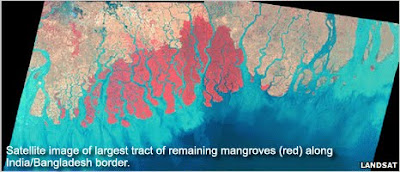 With the recent Gulf Oil Spill disaster, the subject of mangroves has become a hot topic. We have all seen the images of oil lapping at the roots of mangroves in Louisiana and Florida, choking the life that not only is growing from the silty bottom on up, but which also surrounds the mangroves in the form of shrimp, sea larvae, and newly hatched fish seeking protection.
With the recent Gulf Oil Spill disaster, the subject of mangroves has become a hot topic. We have all seen the images of oil lapping at the roots of mangroves in Louisiana and Florida, choking the life that not only is growing from the silty bottom on up, but which also surrounds the mangroves in the form of shrimp, sea larvae, and newly hatched fish seeking protection.Now, a new study published in Global Ecology and Biogeography warns that the world's entire acreage of mangroves has been overestimated, that there is less than originally thought and that we are losing these critically important aquatic forests at an alarming rate.
Scientists from the United States, Australia, and Kenya poured over the most recent satellite data taken by the U.S. Geological Survey for its Global Land Survey, along with other archive images, that utilize remarkable high resolution Landsat satellite photographs. By comparing them to previous estimates by the United Nation's Food and Agriculture Organization (FAO), it was found that overall, mangrove forests are 12.9% less than previously thought. And since 1980, 20% to 30% has been lost globally, with mangrove forests disappearing at an average rate of 1% per year.
As reported by BBC Earth News, Dr. Chandra Giri, one of the scientists involved in the study, warned, "13% is significant, especially as it is disappearing faster than inland tropical forests. We need to preserve the remaining mangrove forests with urgency otherwise they might disappear."
 What makes mangroves so important? First, they serve as a protective nursery for a variety of sea life. Their root structures and the action of the roots on the fine ocean sediment make for ideal habitat conditions for oysters, sponges, algae, shrimp, lobsters and other small crustaceans - not to mention offering a safe haven for a variety of larval and juvenile fish. The loss of mangroves as nurseries can have a profound impact on adult populations further out at sea.
What makes mangroves so important? First, they serve as a protective nursery for a variety of sea life. Their root structures and the action of the roots on the fine ocean sediment make for ideal habitat conditions for oysters, sponges, algae, shrimp, lobsters and other small crustaceans - not to mention offering a safe haven for a variety of larval and juvenile fish. The loss of mangroves as nurseries can have a profound impact on adult populations further out at sea.Because of the mangroves' massive root networks, they also serve to protect fragile coastlines from erosion. The impact of daily tidal ebb and flow - and even the extreme action of storm surge or tsunami movements - are moderated by this botanical line of defense. And the mangroves can assist in filtering and maintaining water and air quality by sequestering CO2 and helping the sediments to retain gases and heavy metals.
 While the Gulf of Mexico's mangroves have received a lot of publicity of late, 40% of the world's mangroves are located in Asia (compared to North and Central America's 15%). Often based at the mouths of large delta river areas, the shrinking mangrove forests pose a major risk to local communities both from heightened exposure to the elements and from the negative impact on seafood that is a means of economic or nutritional survival.
While the Gulf of Mexico's mangroves have received a lot of publicity of late, 40% of the world's mangroves are located in Asia (compared to North and Central America's 15%). Often based at the mouths of large delta river areas, the shrinking mangrove forests pose a major risk to local communities both from heightened exposure to the elements and from the negative impact on seafood that is a means of economic or nutritional survival.Read an abstract of the research study.
Read more about the study in Earth News.
No comments:
Post a Comment